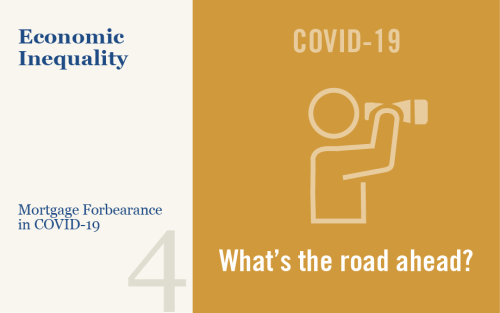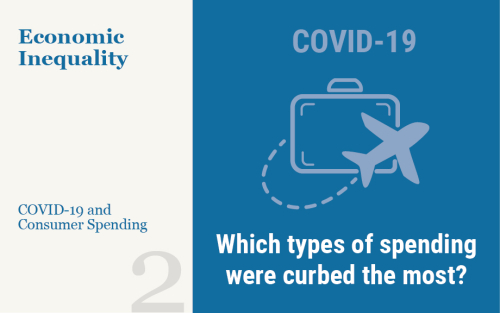The New York Fed DSGE Model Forecast—September 2021

This post presents an update of the economic forecasts generated by the Federal Reserve Bank of New York’s dynamic stochastic general equilibrium (DSGE) model. We describe very briefly our forecast and its change since June 2021.
The New York Fed DSGE Model Forecast—June 2021
This post presents an update of the economic forecasts generated by the Federal Reserve Bank of New York’s dynamic stochastic general equilibrium (DSGE) model. We describe very briefly our forecast and its change since March 2021. As usual, we wish to remind our readers that the DSGE model forecast is not an official New York Fed forecast, but only an input to the Research staff’s overall forecasting process. For more information about the model and variables discussed here, see our DSGE model Q & A.
What’s Next for Forborne Borrowers?

We’ve spent the first three posts of this series discussing who has entered mortgage forbearance, and how their personal finances have developed during the course of the pandemic. In this fourth and final post, we will use Consumer Credit Panel (CCP) data to examine the profiles of those who remain in forbearance and those who have exited, and how the performance of household credit may evolve as the force of the pandemic begins to ebb and the economy reopens and normalizes.
Who’s Ready to Spend? Constrained Consumption across the Income Distribution

Spending on goods and services that were constrained during the pandemic is expected to grow at a fast pace as the economy reopens. In this post, we look at detailed spending data to track which consumption categories were the most constrained by the pandemic due to social distancing. We find that, in 2019, high-income households typically spent relatively more on these pandemic-constrained goods and services. Our findings suggest that these consumers may have strongly reduced consumption during the pandemic and will likely play a crucial role in unleashing pent-up demand when pandemic restrictions ease.
Women’s Labor Force Participation Was Rising to Record Highs—Until the Pandemic Hit

Women’s labor force participation grew precipitously in the latter half of the 20th century, but by around the year 2000, that progress had stalled. In fact, the labor force participation rate for prime-age women (those aged 25 to 54) fell four percentage points between 2000 and 2015, breaking a decades-long trend. However, as the labor market gained traction in the aftermath of the Great Recession, more women were drawn into the labor force. In less than five years, between 2015 and early 2020, women’s labor force participation had recovered nearly all of the ground lost over the prior fifteen years. Then the pandemic hit, erasing these gains. In recent months, as the economy has begun to heal, women’s labor force participation has increased again, but there is much ground to be made up, especially for Black and Hispanic women. A strong labor market with rising wages, as was the case in the years leading up to the pandemic, will be instrumental in bringing more women back into the labor force.
How Do Consumers Believe the Pandemic Will Affect the Economy and Their Households?

In this post we analyze consumer beliefs about the duration of the economic impact of the pandemic and present new evidence on their expected spending, income, debt delinquency, and employment outcomes, conditional on different scenarios for the future path of the pandemic. We find that between June and August respondents to the New York Fed Survey of Consumer Expectations (SCE) have grown less optimistic about the pandemic’s economic consequences ending in the near future and also about the likelihood of feeling comfortable in crowded places within the next three months. Although labor market expectations of respondents differ considerably across fairly extreme scenarios for the evolution of the COVID pandemic, the difference in other economic outcomes across scenarios appear relatively moderate on average. There is, however, substantial heterogeneity in these economic outcomes and some vulnerable groups (for example, lower income, non-white) appear considerably more exposed to the evolution of the pandemic.
Helping State and Local Governments Stay Liquid

On April 9, the Federal Reserve announced up to $2.3 trillion in new support for the economy in response to the coronavirus pandemic. Among the initiatives is the Municipal Liquidity Facility (MLF), intended to support state and local governments. The details of the facility are described in the term sheet. The state and local sector is a unique but very important part of the economy. This post lays out some of the economics of the sector and the needs that the facility intends to satisfy.
How Do the Fed’s MBS Holdings Affect the Economy?

In our previous post, we discussed the meaning of the term “credit allocation” and how it relates to the Federal Reserve’s holdings of agency mortgage-backed securities (MBS). We concluded that the Fed’s MBS holdings do not pose significant credit risk but that the Fed does influence the relative market price of credit when it purchases agency MBS, and this indirectly influences decisions by investors. Today, we take the next step and discuss how the Fed’s MBS purchases affect the U.S. economy and, in particular, how the effect of MBS purchases can differ from the effect of purchases of Treasury securities.
A Long Road to Economic Recovery for the U.S. Virgin Islands
The U.S. Virgin Islands are a small and unique component of the Second Federal Reserve District.










 RSS Feed
RSS Feed Follow Liberty Street Economics
Follow Liberty Street Economics